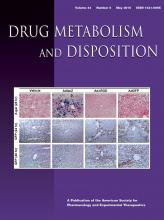Abstract
Methods to predict the pharmacokinetics of drugs in humans from in vitro data have been established, but corresponding methods to predict exposure to circulating metabolites are unproven. The objective of this study was to use in vitro methods combined with static and dynamic physiologically based pharmacokinetic (PBPK) models to predict metabolite exposures, using midazolam and its major metabolites as a test system. Intrinsic clearances (CLint) of formation of individual metabolites were determined using human liver microsomes. Metabolic CLint of hydroxymidazolam metabolites via oxidation and glucuronidation were also determined. Passive diffusion intrinsic clearances of hydroxymidazolam metabolites were determined using sandwich cultured human hepatocytes and the combination of this term along with the metabolic CLint, and liver blood flow was used to estimate the fraction of the metabolite that can enter the systemic circulation after formation in the liver. The metabolite/parent drug area under the plasma concentration-time curve ratio (AUCm/AUCp) was predicted using a static model relating the fraction of midazolam clearance to each metabolite, the clearance rates of midazolam and hydroxymidazolam metabolites, and the availability of the metabolites. Additionally, the human disposition of midazolam metabolites was simulated using a SimCYP PBPK model. Both approaches yielded AUCm/AUCp ratios that were in agreement with the in vivo ratios. This study shows that in vivo midazolam metabolite exposure can be predicted from in vitro data and PBPK modeling. This study emphasized the importance of metabolite systemic availability from its tissue of formation, which remains a challenge to quantitative prediction.
- Copyright © 2016 by The American Society for Pharmacology and Experimental Therapeutics
DMD articles become freely available 12 months after publication, and remain freely available for 5 years.Non-open access articles that fall outside this five year window are available only to institutional subscribers and current ASPET members, or through the article purchase feature at the bottom of the page.
|






